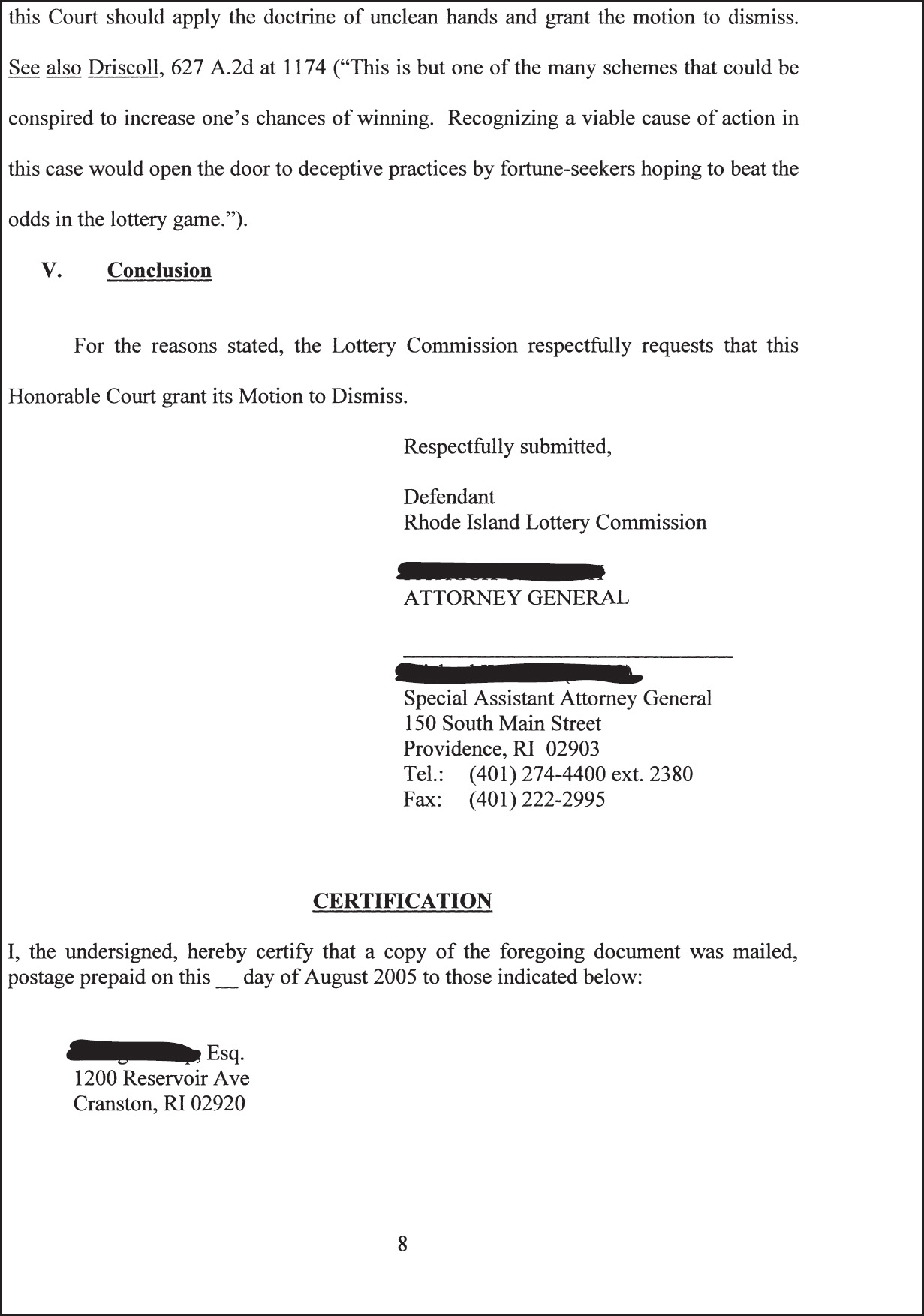1101115 |
Professional Writing for the Courts |
Legal writing should be formal. I do not like contractions. Write out everything. The biggest problem I run into is that the writing is too casual. Refrain from using long, “fancy” words if you do not know the meaning of them. Legal arguments should start with your strongest point and go from there. Always lead with your strongest argument for both oral speaking to the court and in writing.
—Jennifer Kelly, lawyer, Program for Special Advocacy
for Children in State Care (CASA)
What you will learn in this chapter:
• The types of writing and the writing process for professionals in the judicial courts
• The attention to detail required for clear and precise writing
• An opportunity to comment and improve on actual documents from the courts
Effective communication is one of the most important elements of training police officers in dealing with domestic violence cases. This involves both speaking to people and actively listening, and observing demeanor, body language, and other unspoken cues given by those on the scene. Active communication can assist officers in furthering investigations, determining who the predominant aggressors are, and showing the victim that abusive behavior is unacceptable. A positive interaction with law enforcement makes a huge impact on whether victims see the criminal justice system as a resource in escaping dangerous situations.
Writing Reports for the Courts
We can safely assume that almost anything we write on the job may later come under scrutiny in a court proceeding. A tiny percentage will actually appear in court during our careers, but keep in mind that anything can. Effective report writing for the courts is a crucial element to the successful outcome of our responsibilities in justice professions. For almost every action related to probation and parole, there is an official written record 112that contains the facts of the case. Probation and parole reports often include boxes or sections that require only minimum information, but these forms almost always require a case narrative that includes descriptive information. Above all, we need to remember that our writing for the courts is one in a chain of professional writing that comprises a permanent record of a case, which may very well have a direct impact on the case and the individual(s) involved.
We need to be mindful of our audience when preparing a report for the courts. Who will read the report? Readers may include the investigating team, a supervisor, the prosecuting attorney, the defense attorney, judges, jurors, news reporters, city agencies, along with others. Because of this wide variety of readers, our writing should avoid jargon and shorthand abbreviations. Be sure to communicate in conventional, simple English. And above all, avoid drawing conclusions that are operating from assumptions of guilt or innocence.
Furthermore, our writing should adhere to conventions of standard written English. Nothing undermines a professional’s reputation more than a report that is confusing, is missing information, uses misspelled words, or is filled with grammatical and mechanical errors.
A well-written court document saves you and your colleagues’ time and expense. This of course leads to better professional outcomes for you and the individual(s) involved in the case. Effective writing for the courts (as well as elsewhere in the justice system) reflects on you and your professional competence. Writing that is poorly done has the opposite effect and may work against professional advancement. Supervisors and administrators are unlikely to trust you with matters of import if you fail to successfully and responsibly handle the day-to-day nitty–gritty on which everything else is built. Consider that a poorly written report for the courts can seriously damage a case and may even lead to legal liability for the justice professional and his or her department.
Clarity in writing is the result of proper organization and the correct use of language. Effective writing for the courts requires a careful balance of economy and clarity.
A well written, comprehensive police report is absolutely crucial to successful criminal prosecution in domestic violence cases. Due to the very complex dynamics between victims and offenders, victims are quite often reluctant to participate in the court process. In the absence of victim testimony, an officer’s description of the scene, the offender’s behavior, inflicted injuries, and most importantly the power and control exerted by the abuser, can make a world of difference. The report paints a picture for the prosecutor, the judge, and other involved parties that helps keep victims safe by holding offenders accountable for their actions.
—Melissa Leahey, MS, outreach coordinator for the
Pretrial Services Unit of the Rhode Island District Court
EXERCISE Court Report
Take a close look at the original court report that follows. Correct any errors you find. Be sure to think about the reader who will be depending on your notes. And remember that professionals who can write with clarity, credibility, and confidence become quickly indispensable.
113 Original Court Report
Original Court Report
This matter is before the court for presentment on a 32F. The defendant left the state without permission from probation. On 10/6/14 we were contacted by the director who stated subject was in their program with a completion date of 10/7/14. They asked permission for subject to stay until 11/8/14 so that he could be in their sober house for 30 days. PO Smith sent a travel permit to program asking subject to sign and return a copy as well as to contact him every Wednesday until he returned to the state. Travel permit was never returned signed to PO nor did subject ever contact PO Smith. PO Smith contacted subjects family on 12/23/14 and they told him that defendant had not yet returned to the state but he was expected for the holidays.
On 12/30/14 this supervisor asked PO Smith to telephone subject and tell him he had to report to the courthouse within one hour. Subject never showed up. At 1 pm supervisor called subject and after several time and one time that he hung up on this supervisor, he was instructed to report to the office at the Kern County Courthouse at 9 am on 12-31-14. Subject failed to report for that appointment also.
At this time it is respectfully requested that the court order subject to report to probation and instruct him that he is not to leave the state. Please place matter on for review in one month to be sure defendant has complied with the courts order.
114 Improved Court Report
Improved Court Report
Jeffrey Branson’s case is before the court for parole violation (32F). ![]() The defendant left the State of California without permission from his probation officer.
The defendant left the State of California without permission from his probation officer. ![]() On 10/6/14 A. Smith, the director of Sober House, contacted the Department of Corrections.
On 10/6/14 A. Smith, the director of Sober House, contacted the Department of Corrections. ![]() A. Smith stated that the defendant was scheduled to complete the Sober House program by 10/7/14.
A. Smith stated that the defendant was scheduled to complete the Sober House program by 10/7/14. ![]() A. Smith asked permission for the defendant to remain in the program until 11/8/14 in order for the defendant to complete a full 30-day program.
A. Smith asked permission for the defendant to remain in the program until 11/8/14 in order for the defendant to complete a full 30-day program. ![]() The Parole Officer, B. Jones, sent a travel permit to the Sober House program asking the defendant to sign and return a copy of the travel permit as well as to contact his parole officer every Wednesday until the defendant returned to California.
The Parole Officer, B. Jones, sent a travel permit to the Sober House program asking the defendant to sign and return a copy of the travel permit as well as to contact his parole officer every Wednesday until the defendant returned to California. ![]() The defendant never returned the travel permit form to his parole officer;
The defendant never returned the travel permit form to his parole officer; ![]() nor did the defendant ever make contact with his parole officer.
nor did the defendant ever make contact with his parole officer. ![]() As a result, B. Jones contacted the defendant’s family on 12/23/14 and the defendant’s mother told B. Jones that the defendant had not yet returned to California but he was expected for the holidays.
As a result, B. Jones contacted the defendant’s family on 12/23/14 and the defendant’s mother told B. Jones that the defendant had not yet returned to California but he was expected for the holidays. ![]()
115On 12/30/14 the Department of Correction’s supervisor, J. Jackson, asked the parole officer, B. Jones, to telephone the defendant and tell him he had to report to the courthouse within one hour. ![]() The defendant did not show up.
The defendant did not show up. ![]() At 1:00 p.m. of the same day J. Jackson called the defendant several times until the defendant answered.
At 1:00 p.m. of the same day J. Jackson called the defendant several times until the defendant answered. ![]() J. Jackson instructed the defendant to report to the Kern county Courthouse at 9:00 a.m. on 12/31/14.
J. Jackson instructed the defendant to report to the Kern county Courthouse at 9:00 a.m. on 12/31/14. ![]() The defendant again failed to report.
The defendant again failed to report. ![]()
At this time the Department of Corrections respectfully requests that the court order the defendant to report to his probation and parole officer and instruct the defendant that he is not to leave the State of California. ![]() Please place this matter on review after one month to be sure defendant has complied with the court’s order.
Please place this matter on review after one month to be sure defendant has complied with the court’s order. ![]()
Explanations of Corrections
1. The original report included jargon, inconsistent and imprecise language, passive voice, and incomplete sentences that lacked specific information. Though there is no single way to write a perfect report, there are sure-fire skills that will improve our writing. Note the following corrections.
2. The first sentence avoids the ambiguous antecedent, “this,” and refers precisely to the defendant’s name and case. The improved version also avoids jargon and shorthand. Law 32F entitles a judge to revoke the defendant’s probation.
3. The second sentence indicates clearly which state and does not assume that the reader knows already.
4. The third sentence includes specific information by naming individuals and avoids vague pronoun references that are both imprecise and incorrect. The third sentence also revises the sentence into the active voice rather than the passive voice. Active voice helps the reader to know who is doing what to whom. Passive voice is often wordy and vague.
5. The fourth sentence includes specific information not included in the original version.
6. The name of the parole officer and other specific information have been included; the abbreviation PO has been spelled out.
7. A semicolon replaced the comma, because the punctuation separates two otherwise complete sentences.
8. Language has been made consistent with what came before. The use of the term defendant has been regularized throughout the report.
9. We have added specific information so that the reader will know who is doing what to whom.
10. Use of the “defendant’s family” requires an apostrophe rather than “the subjects” family.
11. We replaced “this supervisor” with name for clarity; the original was ambiguous. Specific names have been included rather than the ambiguous and awkward, “this supervisor.”
12. Corrected for clarity. The original was too informal.
13. Language has been made consistent with the rest of the report. Formatting of date and time has been made consistent with the rest of the report.
14. Language has been made consistent with the rest of the report. Formatting of date and time has been made consistent with the rest of the report.
15. Original language was informal and judgmental.
16. Passive voice.
17. Possessive case.
116Process notes help workers identify the important elements of a case and plan next steps. Process notes are internal documents, for colleagues to review and plan. Because process notes are shared among work groups, writing should be accurate and competent. After colleagues have competed their reviews, the process notes should be destroyed, replaced with official court records. For our purposes, the following process note, with 17 writing errors, is useful for practicing writing for the courts.
 Original
Original
CALL FROM CASA/GAL PROGRAM ADMINISTRATOR
At an emergency custody hearing, the CASA/GAL program recieved a referral regarding a 4 year old female named Kaylee Moore. The child’s mother, Trisha Moore, had taken her to the ER with severe burns on both legs. A toxicology screen at the ER reveals that Kaylee had been exposed to chemicals used to manufacture methamphetamine. The child is currently in the hospital for a few days. Mother was arrested for drug possession, Father hasn’t been located yet.
According to CASA/GAL program administrator CPS caseworker Wilma Bailey has informed the court that the father is Jimmy Hansen a member of the Big River Nation. She has contacted the tribal council about Kaylees’ case. Ms. Bailey had also informed the court that she ran a criminal background check on both parents. The mother, Trisha Moore, has one prior arrest for drug possession, the father has three serious priors, for driving under the influence, for operating a vehicle without a license, and for resisting arrest.
The judge at the hearing ruled that their was sufficient reason to remove the child from the care of her mother, set a hearing date for further review of the case, and ordered that a CASA/GAL volunteer be appointed.
117 Corrected
Corrected
CALL FROM CASA/GAL PROGRAM ADMINISTRATOR
At an emergency custody hearing, the CASA/GAL program received ![]() a referral regarding a 4-year-old
a referral regarding a 4-year-old ![]() female named Kaylee Moore. The child’s mother, Trisha Moore, had taken Kaylee
female named Kaylee Moore. The child’s mother, Trisha Moore, had taken Kaylee ![]() to the ER with second-degree
to the ER with second-degree ![]() burns on both legs. A toxicology screen at the ER revealed
burns on both legs. A toxicology screen at the ER revealed ![]() that Kaylee had been exposed to chemicals used to manufacture methamphetamine. The child is currently in the hospital for a few days. Mother was arrested for drug possession.
that Kaylee had been exposed to chemicals used to manufacture methamphetamine. The child is currently in the hospital for a few days. Mother was arrested for drug possession. ![]() Father hasn’t been located.
Father hasn’t been located. ![]()
According to CASA/GAL program administrator, ![]() CPS caseworker Wilma Bailey informed
CPS caseworker Wilma Bailey informed ![]()
the court that Father ![]() is Jimmy Hansen,
is Jimmy Hansen, ![]() a member of the Big River Nation. She has contacted the tribal council about Kaylee’s
a member of the Big River Nation. She has contacted the tribal council about Kaylee’s ![]() case. Ms. Bailey
case. Ms. Bailey ![]() also informed the court that she ran a criminal background check on both parents. The mother, Trisha Moore, has one prior arrest for drug possession;
also informed the court that she ran a criminal background check on both parents. The mother, Trisha Moore, has one prior arrest for drug possession; ![]() Father
Father ![]() has three
has three ![]() priors, for driving under the influence, for operating a vehicle without a license, and for resisting arrest. According to the record, the three priors resulted from the same episode in 2009, when he was 19 years old.
priors, for driving under the influence, for operating a vehicle without a license, and for resisting arrest. According to the record, the three priors resulted from the same episode in 2009, when he was 19 years old. ![]()
The judge at the hearing ruled that there ![]() was sufficient reason to remove the child from the care of her mother. The judge set a hearing date for further review of the case and ordered that a CASA/GAL volunteer be appointed.
was sufficient reason to remove the child from the care of her mother. The judge set a hearing date for further review of the case and ordered that a CASA/GAL volunteer be appointed. ![]()
Explanation of Corrections
1. Spelling
2. Hyphenate 4-year-old when it is a modifying phrase
3. Kaylee instead of “her,” which refers to the mother
4. “Severe” is vague and opinionated; report the facts
5. Syntax error: the narrative should stay in the same tense, in this case the past tense
6. Consistency error: the narrative has been using Mother and Father without the article
7. “Yet” is unnecessary
8. Comma between the introductory dependent phrase and the independent phrase
9. Simple past tense—the event happened once in the past
10. Comma between independent and dependent phrases
11. Simple past tense—see #9
12. Comma-splice (run-on sentence): two independent phrases should be separated by a semicolon or rewritten as two complete sentences. They also may be separated by a conjunction, then a comma, e.g., and,
13. Consistency—see #6
14. “Serious” is opinion—see #4
15. If you know relevant facts, include them. In this case, the missing information is important. The original sentence is prejudicial. If you cannot learn important facts, indicate that details are not available.
16. Homophone
17. The original sentence lacked parallelism and was confusing. We divided it into three precise sentences.
118Breakout Writing Assignment Interview Transcript
The following is an inmate timeline taken from an interview transcript inside the prison just before his parole. The parole officer assigned to the case has asked you to write a short narrative on the inmate’s history to present to the judge. The state is now considering what is called in his state “a 32F,” which means a revocation of his parole, because he recently failed one urine test. Your supervisor asked you to write a narrative to present to the court that will help determine his eligibility. The judge will use this narrative to assess whether the inmate might remain on parole with a warning or whether he is returned to prison to serve the remaining years of his sentence. You review his case file and make a recommendation to the court. Should he stay on parole? Read the inmate’s timeline and write a neutral report to the judge.
Name: Joe Roccipella
DOB: 8/12/65
Ages 7–11: Good childhood. Family involvement/family outings
Age 7 to father’s death: Father would beat us. Disciplinarian. Alcoholic.
Mom would object to beatings, and they would fight a lot.
Middle School. “I used to love going to school.” “School was fun.”
11 years: Mom shot dad. She never told us, and I only found out when I was 18.
Age 11–12: Mom went to prison, and after that I went to live with my aunt. Family split up. Aunt used to beat my brother and me.
Age 13: We left my aunt’s house & went to another’s. My older brother went on his own, did not want to live with family members anymore.
We would visit mom in prison after church on Sundays, but we didn’t understand it was prison.
Age 14–16: I attended Central High School. I was kicked out. I was acting out all the time. I skipped school a lot. Got in with the wrong crowd.
Mom got out of prison. Everyone moved back to her house.
Age 16–17: This is when I started getting really out of control. I attended an alternative school, and I stayed in it for a few years. It was good. I liked it.
Friends drank. I was a follower, trying to fit in. Robbed soda trucks, stole car radios. I was not my own person.
Friends got caught and went to Training School for 6 months. Their moms blamed it on me.
Age 17: Things really went downhill. Started drinking and smoking and hanging out with an older crowd. Heavy IV drug use. My brother got AIDS from needle sharing and died. Took him a while to die, though.
1983: First bid in prison for B & E.
Age 20: B&E. Served 3 years at Max. It was crazy/rough in there. Started doing whatever anybody else in there was doing. It was like living in the projects, you know, prison was dangerous, too.
Age 23: Met my wife Joseline outside Max at an arts and crafts tables.
1988: Once released, we had our daughter, Sarah (now age 25)
1988–1990: 2nd bid for possession/selling heroin. As soon as I got out, I came right back in. Was still using crack/heroine. Out of control. That bid was for possession/selling heroin.
Joseline brought Sarah in the very next day after her birth for a visit. Ever since then, my daughter and I are very close.
1191990–1993 I worked with Joseline at the newspaper. We put papers together 11 p.m. to 7 a.m. Also worked 3 to 11 at a pallet company.
1991–1992 Sarah was 4 or 5 years old: I got her mom hooked on heroin. Feel guilty about that. Was also dealing out of the house. “I guess this was neglect in a way.” Joseline knew what was going on. I was really out of control.
I had happy times with my daughter. I would get my daughter up, get her dressed and ready for school every day. I would also go and pick her up. In the afternoons, we would go to a movie or go get ice cream.
1991 or so: Joseline had an abortion. (I just found out about this a couple of years ago. I had no idea, but I understand why she did it.) We probably weren’t fit to be parents.
1992: This is when I started my current bid. A friend came over to the house. He convinced me to rob a liquor store with him. We were both high on drugs/alcohol – and so I said yes.
The liquor store clerk identified his car and called police. We got home after the robbery and while outside with a dope customer, police caught up with us. Both customer and I were locked up in police cars when we heard shots. Cops entered house, found my friend hiding in a closet. The friend shot the cop point blank in the face when the cop opened the closet door. They told me he died on the way to the hospital. Police shot my friend. Multiple times. He died in the closet.
Once other cops heard the shot, police started shooting at the house. Joseline and Sarah were still inside. Sarah remembers seeing the friend get shot in the leg. I realize now how traumatizing it must have been for her. Over 40 shell casings were found inside. The cops just killed my friend. They went crazy.
I was charged with two felony murders, consecutive life sentences, plus the robbery/heroin/parole violation, which I still had 9 years to serve.
I guess I had a moment of weakness and smoked a little pot with some friends, which is why I failed the piss test. I know this is why they want to send me back to prison. I’ve never been a violent man. It seems ironic that I’ve been charged with felony murder. I mean, I know why they charged me with felony murder, but I was sitting in the squad car when all the bullets went flying. Seems like I will never move on from that fateful day. But in many ways, I’m thankful. I think prison saved my life back then when I was going wild. Now, I guess I just wasn’t thinking, but I have the good fortune of knowing my daughter, and now she has a daughter. I’m a grandpa now.
Conclusion
As you can see by Joe’s testimony, the layers are complex and it is important to write as objectively and mindfully as possible. Everyone you may encounter will have a complex history, and it is important to write with precision and clarity. You can assume that during your career you will write documents that court personnel will review. The stakes could not be higher for both the justice professionals and the individuals whose cases are adjudicated in court. Also, your own professional reputation may be affected by the quality and comprehensiveness of your reports. One judge once told this author that there are only a handful of writers she knows and trusts to write responsibly where court time is used expediously because she knows she can trust the writer to provide a comprehensive, objective, and mindful report. When she does not have their particular reports in front of her, she says that she uses valuable court time to interview the defendant herself. Finally, it is important to remember that we cannot always know whether a document will receive court review. This means that when we write, we must always be complete, comprehensive, well organized, devoid of judgmental language, free of jargon, and grammatically correct.
120Field Documents
Following are some actual documents, edited to protect confidentiality.
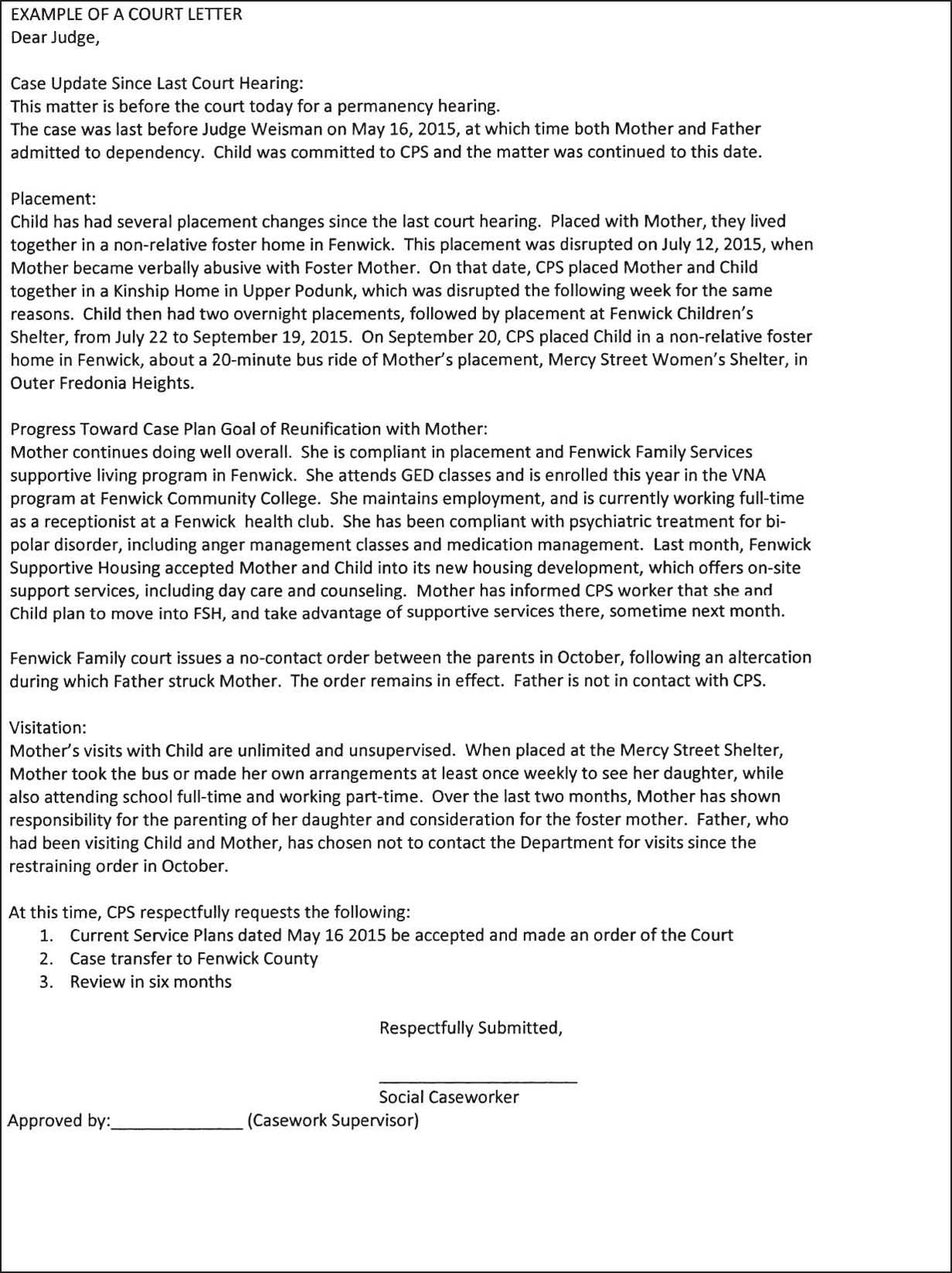
121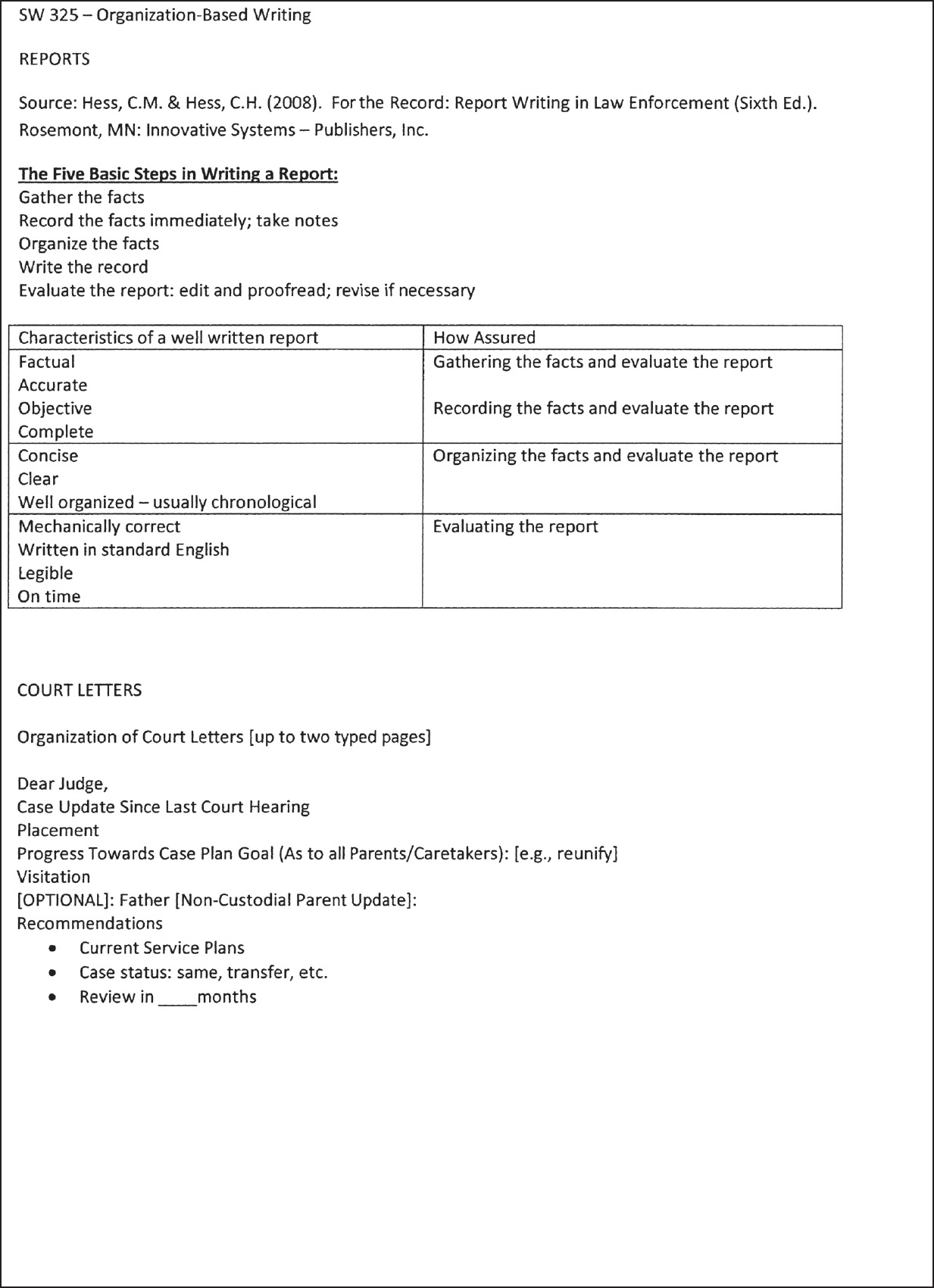
122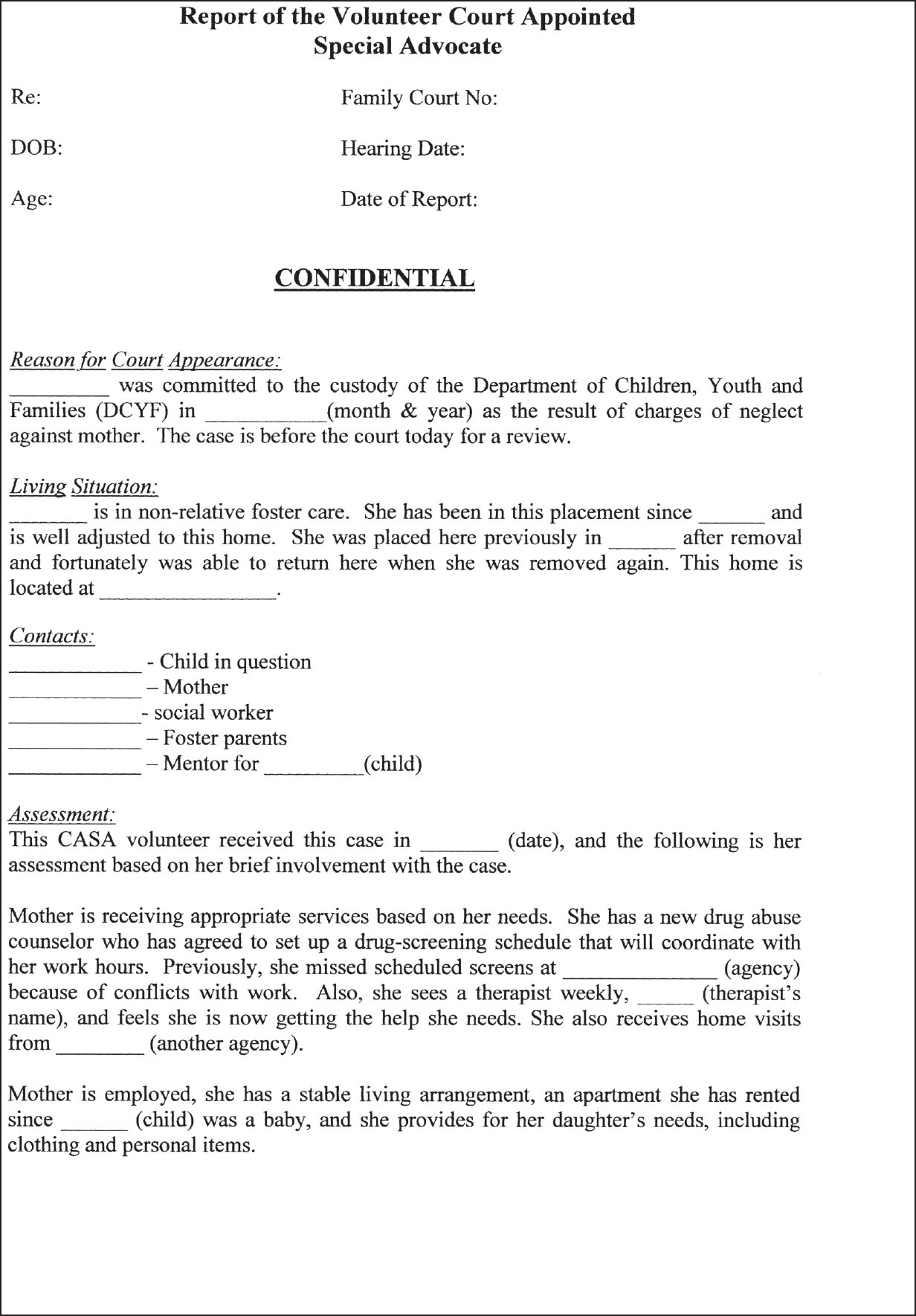
123Guidelines for Guardian ad litem
Summary Form Plan
[Note: This form can be used for the guardian ad litem, a person the court appoints to investigate the case. The guardian ad litem can offer options, services, or solutions based on their interview(s) with the parent(s) that reflect a standard of what is in the best interest of the child. This form, or one like it, often accompanies a divorce or parental rights case in family court.]
Guidelines: Be sure to include the following in your report:
• names of all parties involved
• names of all children
• Ethnicity, cultural identity of children
• Court date/petition date
• if allegations of abuse or neglect
• amount of time and number of placements children are in foster care, if applicable
• current placement of children
Prior Court Involvement:

Outline case status or summary, including any court ordered services:

Persons involved and their relationship to the child(ren):

124Reports on compliance or non-compliance with previous court orders or visitation plan:

Changes in circumstances of child(ren) or family members:
![]()
NEEDS & WISHES OF THE CHILD(REN):
Placement:
![]()
Educational:

Psychological, emotional, health, or other care needs:

Visitation Plans:

125Safety Plan:

Financial/material needs
![]()
Wishes of the child(ren) (if able to articulate)
![]()
Guardian ad litem summary and recommendation:

Note: Special thanks to the National Court Appointed Special Advocate Association from which this example was adapted.
Question Guidelines:
Is it likely for the child to be returned home immediately or within the next six months? Is it in the child’s interest to return home? Why or why not?
What are the community resources that can assist the child(ren) and family?
Should legal guardianship with a relative or some other suitable person be established, and if so, what rights and responsibilities should remain with the parents?
Should adoption be pursued? Are there any barriers to the child’s adoption?
Should the child remain in the current placement or be placed in another permanent living arrangement? Explain the pros and cons.
Is there any reason that the filing of a petition for termination of parental rights is not in the best interest of the child?
Is there any other information the court should have in order to make this decision?
126GUARDIAN AD LITEM MONTHLY UPDATE
(THIS IS NOT A COURT REPORT)
[Note: This report form and narrative are provided to a state attorney in the Department of Children, Youth and Families.]
Person Filing Report: ________________________ Date:________________
Case Name: _______________ Attorney assigned to the case: _____________________
Number of hours spent on case: ___(including travel, phone, writing, and court time)
Contact hours with child(ren) this month: _________________________
Number of phone contacts with child(ren) this month:
************************************************************************************************
Identify new developments or concerns since your last contact. Be sure to specify whether you recommend a placement change or justify current placement:

127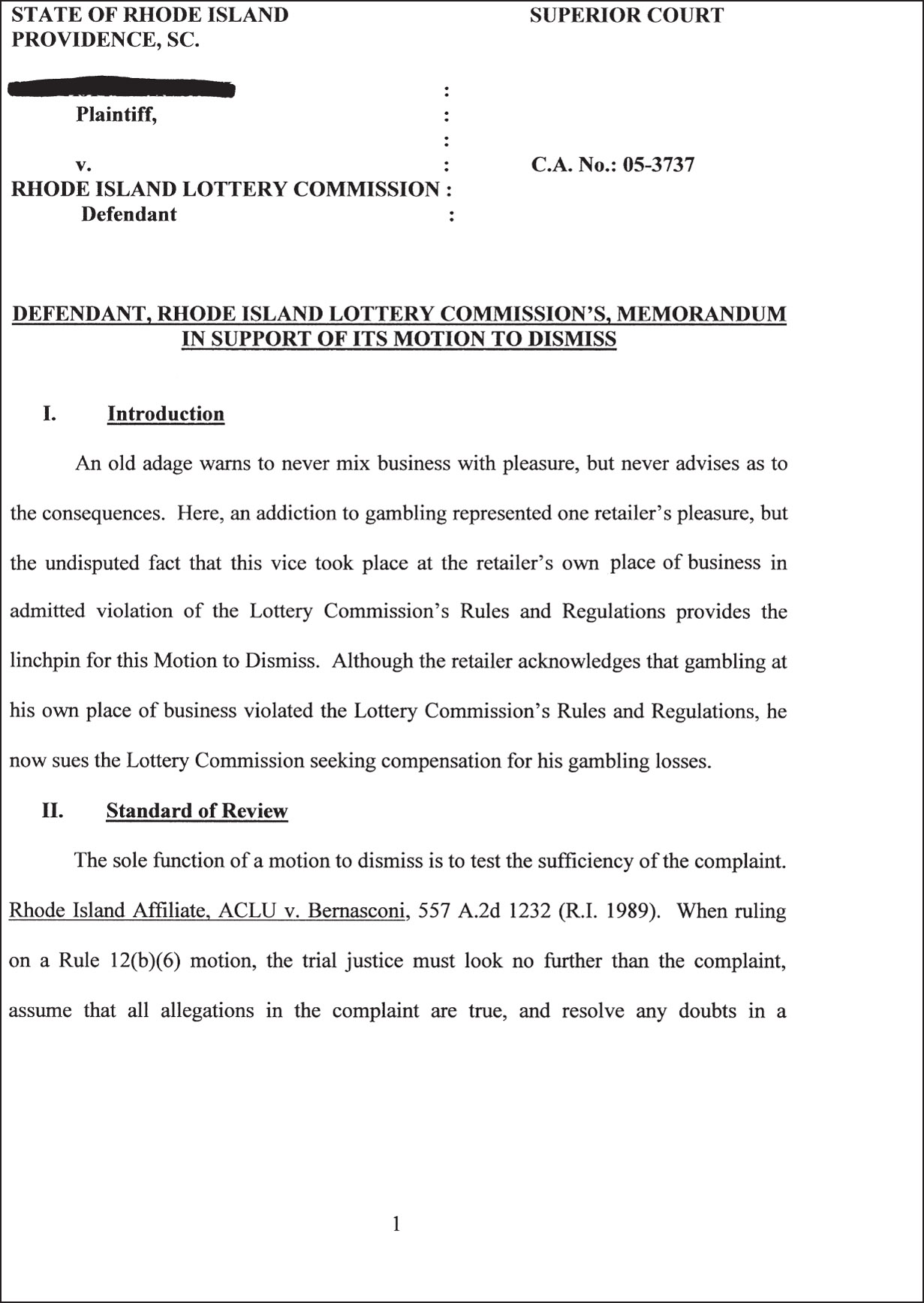
128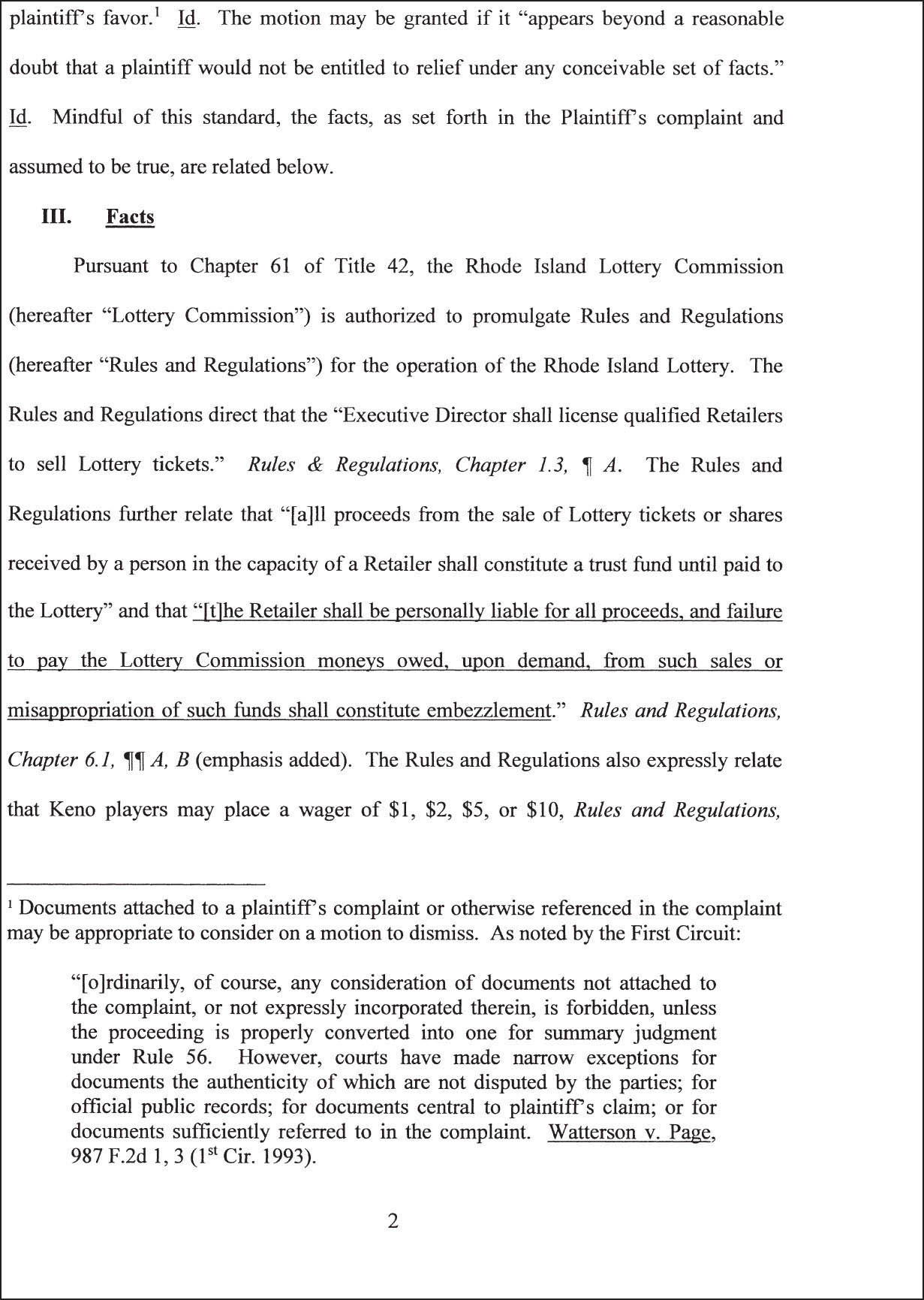
129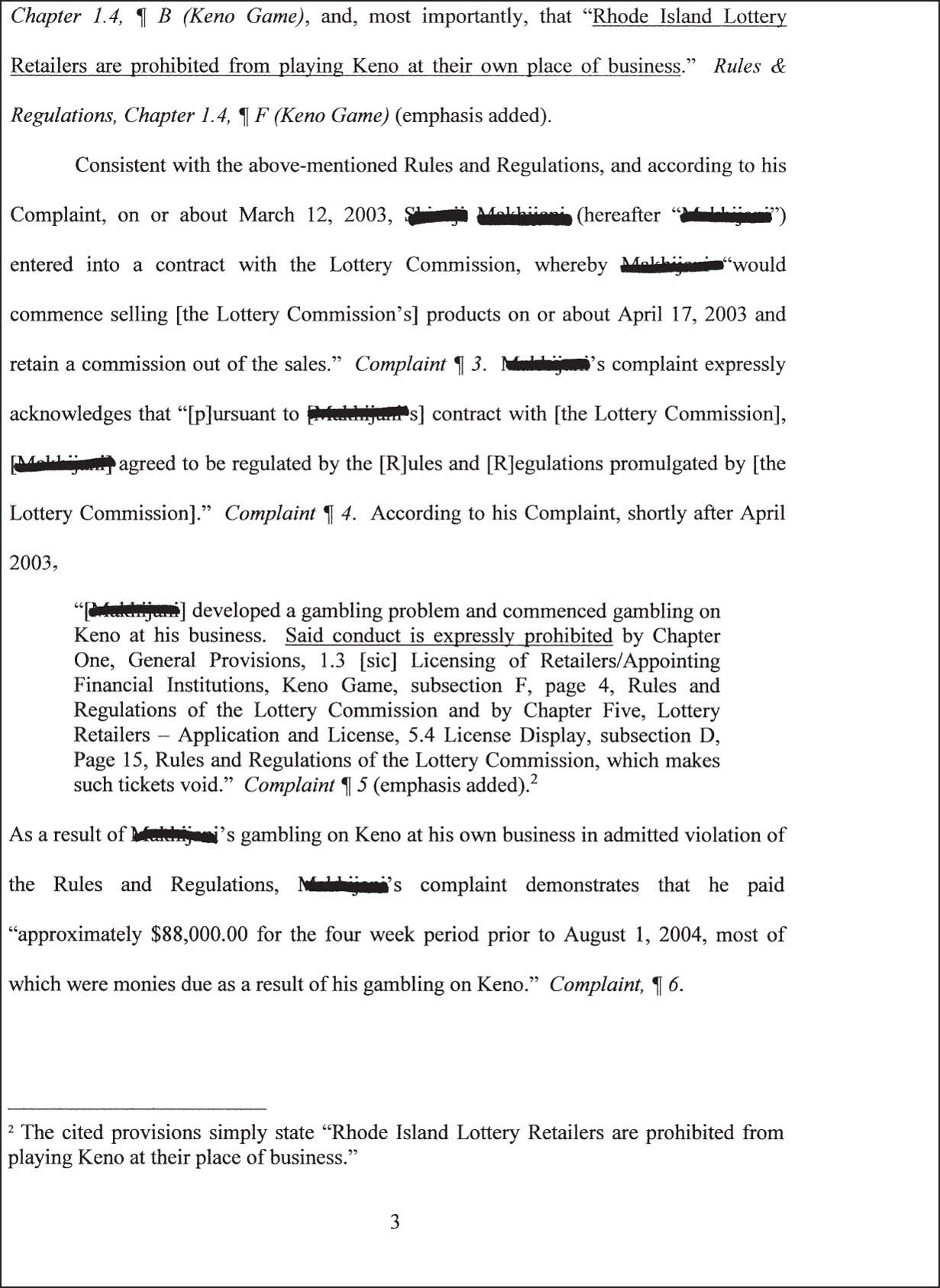
130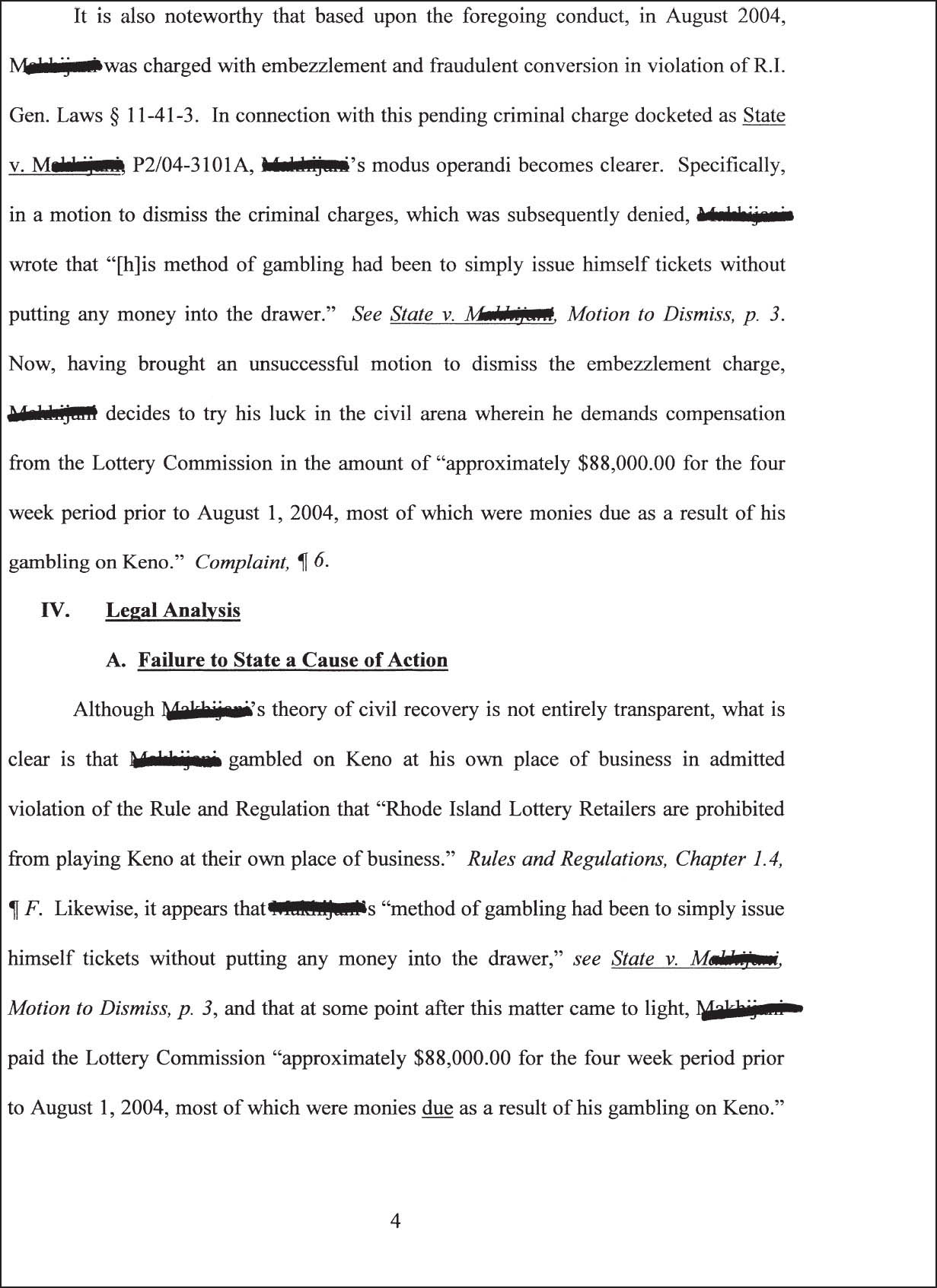
131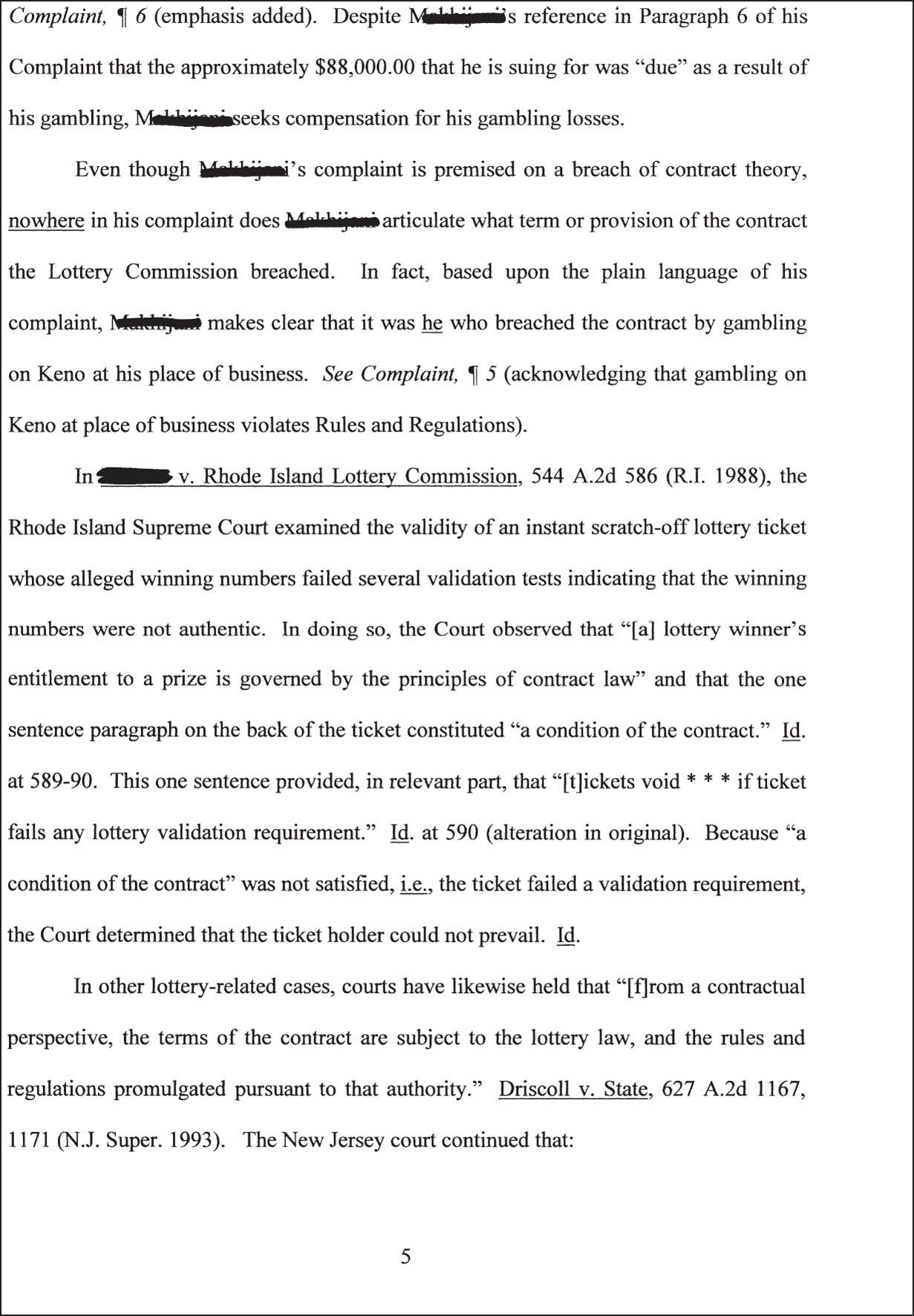
132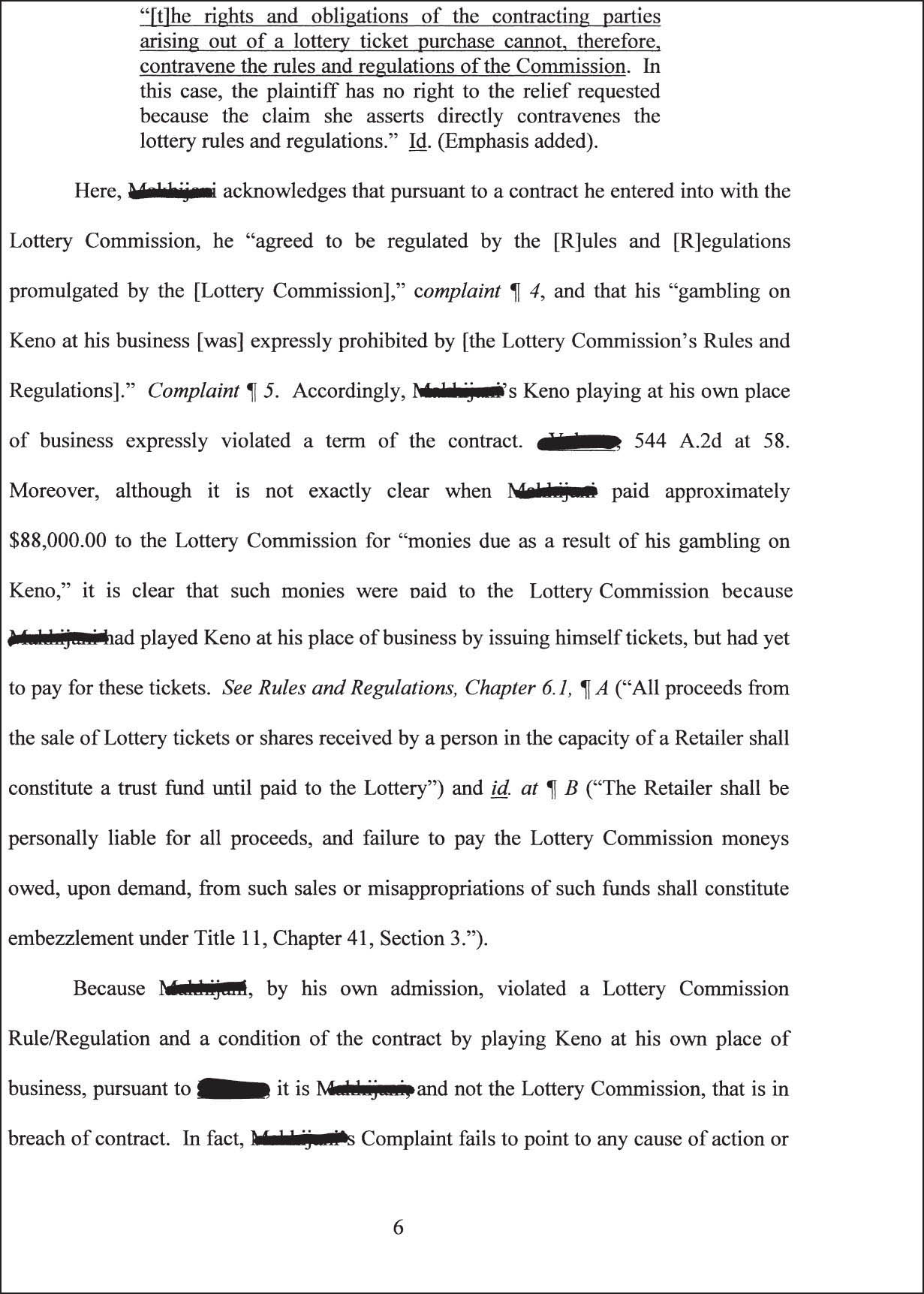
133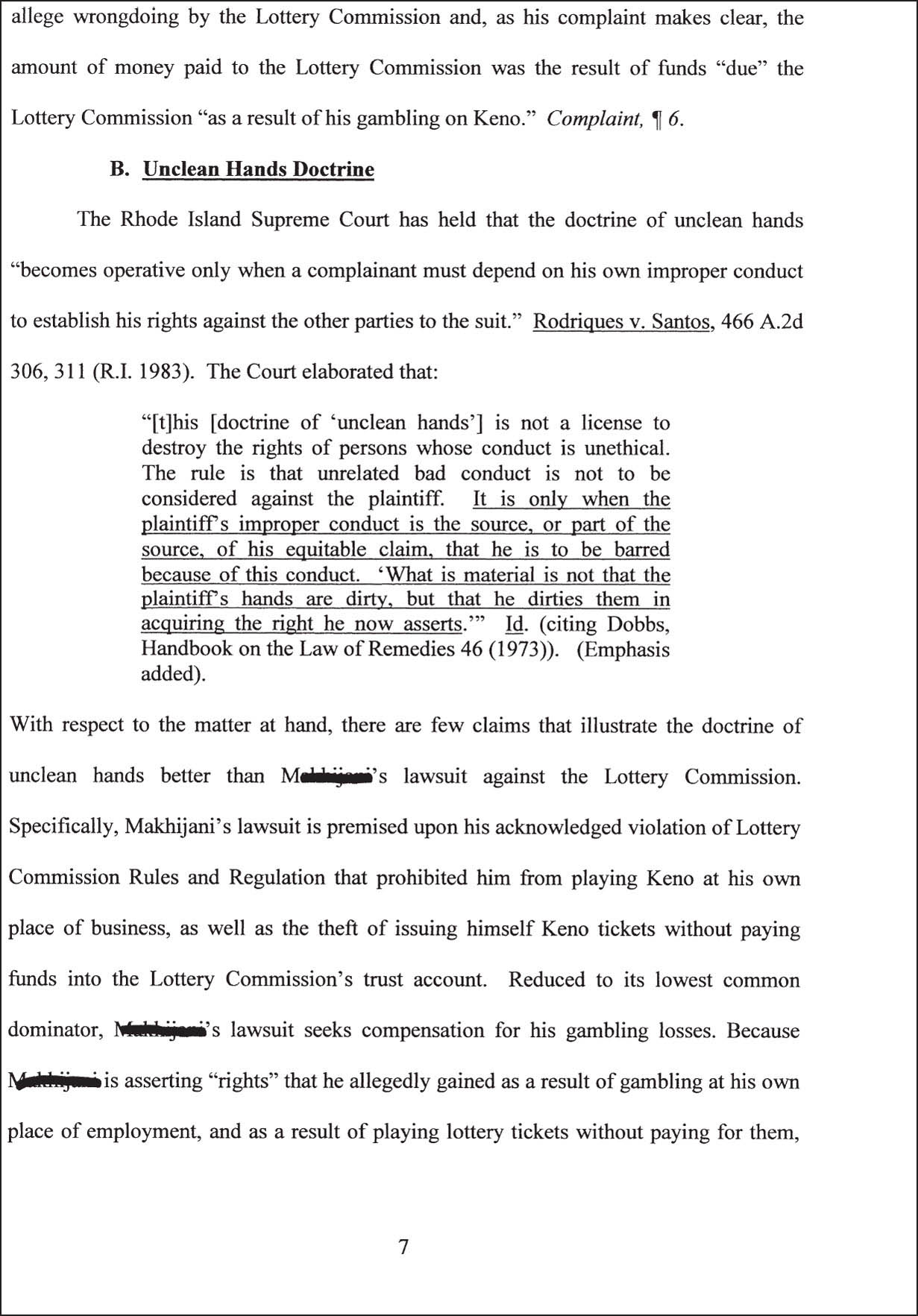
134